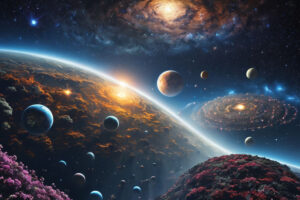The question of life’s origin on Earth has captivated humanity for millennia. One intriguing theory, panspermia, proposes that life isn’t an Earthly invention, but rather came to us from elsewhere in the cosmos.
Panspermia, derived from Greek words meaning “all” and “seed,” suggests that life’s building blocks, or even simple lifeforms themselves, arrived here via meteoroids, asteroids, comets, or even dust. These celestial hitchhikers would have found a welcoming environment on early Earth, setting the stage for the evolution of life as we know it.
There are two main flavors of panspermia:
- Lithopanspermia: This is the classic idea, where microbes or hardier organic molecules are shielded within rocks during space travel. The intense heat of entering Earth’s atmosphere would sterilize the rock’s surface, but life tucked away in the interior could survive and potentially jumpstart biology here.
- Directed Panspermia: This more speculative idea proposes that life was deliberately delivered to Earth by an advanced extraterrestrial civilization. Perhaps they were seeding planets with the building blocks of life, or maybe even spreading pre-existing microbes.
Challenges and Allure of Panspermia
Panspermia faces an uphill battle for scientific acceptance. The harsh environment of space, with its intense radiation and extreme temperatures, is thought to be highly destructive to life. Additionally, we haven’t found any evidence of alien microbes hitching a ride on meteorites despite extensive space exploration.
However, panspermia offers some intriguing advantages:
- It solves the problem of abiogenesis: The origin of life on Earth remains a complex and unsolved scientific question. Panspermia suggests that life arose elsewhere, under potentially more favorable conditions, and bypasses this hurdle.
- It explains life’s ubiquity: If life’s building blocks are readily available in the universe, panspermia suggests life could arise wherever conditions are suitable. This aligns with the growing number of potentially habitable planets being discovered.
The Panspermia Debate: Open Questions
The panspermia debate hinges on finding evidence. If panspermia is true, there could be microbial fossils or organic molecules with an extraterrestrial origin buried deep within meteorites or asteroids. Future missions to Mars and other potentially habitable worlds could play a crucial role in this search.
Another interesting avenue is investigating the possibility of life existing below the surfaces of icy moons or planets, where it might be shielded from the harshness of space.
The panspermia theory, while lacking definitive proof, continues to fire the imagination. It forces us to consider the possibility that life is not an anomaly but rather a natural consequence of the universe’s chemistry, potentially existing in countless places beyond our blue planet.





